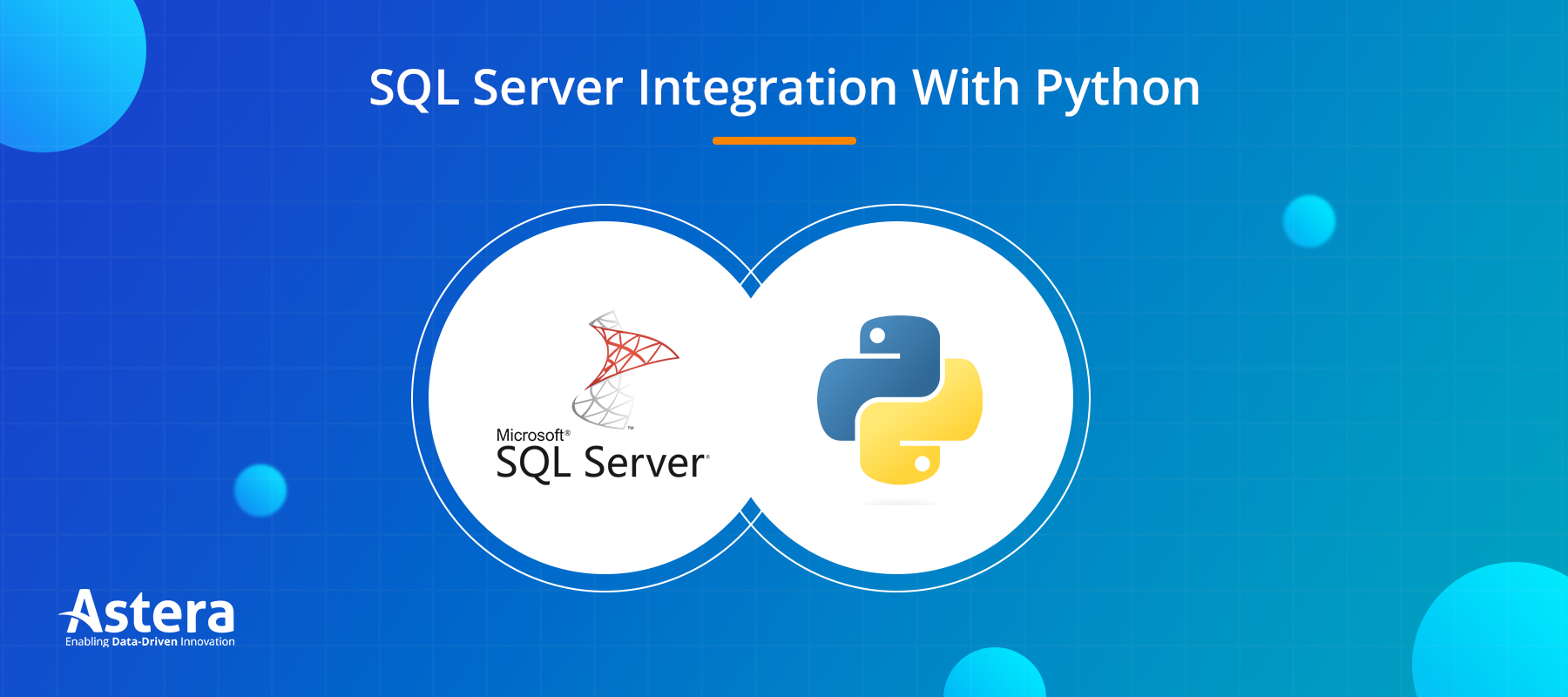As a Python developer, you may find yourself needing to integrate with a SQL database at some point. SQL Server is a popular relational database management system used by many companies, so Python to SQL Server integration is a useful skill to have. Millions of companies around the world use SQL Server, which is one of the most popular relational databases. Its powerful features and scalability make it widely used, and it’s no surprise why. However, integrating it with Python can be a bit tricky. Here is how you can do it.
What are Python and SQL Server?

You can integrate SQL Server with Python without the need for any additional data integration software. This guide will provide you with an overview of the basics so that you can get started quickly and easily.
Developers use Python, a powerful and versatile programming language, for various applications such as web development, game development, machine learning, and data integration. On the other hand, SQL Server is a popular relational database management system (RDBMS) that enables users to store and access data from multiple systems.
When combined, Python and SQL Server provide users with an efficient way to access data stored in SQL Server databases from within Python scripts. Therefore, this opens up a wide range of possibilities for analyzing, reporting, or performing other tasks with the data. Furthermore, Python code allows users to manipulate data stored in SQL Server databases, expanding the capabilities even further.
The process of integrating Python with SQL Server is relatively straightforward, allowing developers to quickly begin leveraging both technologies in their projects. While it is possible to perform all integration tasks manually, there are various other data integration software options available that can simplify the process considerably.
Why Integrate Python and SQL Server?
Integrating Python and SQL Server provides numerous benefits for data analysis and application development.
- Access to robust data storage. SQL Server is a relational database management system that stores and organizes data in tables. Python can connect to SQL Server to query and manipulate this data.
- Leverage the power of Python for data analysis. Python has many libraries for data analysis, machine learning, and visualization. By connecting Python to SQL Server, you can analyze data stored in the database.
- Build data-driven web applications. Python is a popular framework for building web applications. By using Python to connect to SQL Server, you can create data-driven web applications that read and write data in the database.
- Use familiar languages. If you are familiar with Python and SQL, integrating them allows you to leverage the strengths of each language. You can write SQL queries to manipulate data in the database and use Python to build the application logic.
- Robust ecosystem of tools. Python and SQL Server both have many open source libraries and tools to help in development. Integrating these technologies allows you to utilize tools from both ecosystems.
In summary, integrating the power of Python and the data storage capabilities of SQL Server provides a platform for building data-driven applications and analyzing data in powerful ways. With the variety of tools and libraries in both ecosystems, Python and SQL Server are a perfect match for productive development.
Steps for Connecting to SQL Server With Python
Integrating SQL Server with Python can be done in several ways, with the most common way being to use the python library pyodbc. This library provides a layer of abstraction between your code and the ODBC driver, allowing you to write code that is easier to maintain and understand.
The following steps can be used to establish a successful SQL Server integration with Python:
1. Install an ODBC driver for SQL Server
The ODBC driver for SQL Server can be downloaded from the Microsoft Download Center. The driver version you need may depend on your SQL Server version and operating system. Here are some links to download the driver:
2. Import pyodbc into Your Project
To use pyodbc, you’ll need to install it first. You can use pip, the Python package manager, to install pyodbc. Here’s the command to install pyodbc:
pip install pyodbc
3. Create an ODBC Connection Object Using pyodbc
You’ll need to provide the connection details for your SQL Server database in order to create an ODBC connection object. Here’s an example code snippet that shows how to create an ODBC connection object using pyodbc:
import pyodbc conn = pyodbc.connect('DRIVER={SQL Server};SERVER=;DATABASE=;UID=;PWD=')
Replace <server_name>, <database_name>, <username>, and <password> with the actual values for your database.
4. Use the .connect() Method on the Object to Initiate a Connection with SQL Server
Once you have an ODBC connection object, you can use the .connect() method to initiate a connection with SQL Server. Here’s how you can use it:
import pyodbc conn = pyodbc.connect('DRIVER={SQL Server};SERVER=;DATABASE=;UID=;PWD=')
conn.connect()
5. Perform Operations Such as Inserting, Updating, Deleting Data from Your Python Application
Once the connection is established, you can use SQL statements to perform various operations on your SQL Server database from within your Python application. Here’s an example code snippet that shows how to execute a SQL query using pyodbc:
cursor = conn.cursor() cursor.execute("SELECT * FROM ") rows = cursor.fetchall()
Replace <table_name> with the actual name of the table you want to retrieve data from.
6. Close the Connection by Using Either .rollback() Or .commit() Method Depending on Whether You Want Your Transaction Changes to Be Saved or Reverted
Once you’ve completed your database operations, you’ll need to close the connection to avoid resource leaks. You can either use the .rollback() method to revert any uncommitted changes, or the .commit() method to save any changes made to the database.
Advanced SQL Queries in Python and SQL Server

SQL Server and Python offer a wealth of powerful options when it comes to writing advanced SQL queries. With the right combination of development experience and the right tools, you can access insights quickly and efficiently via SQL Server and Python integration.
You can use Python to run advanced queries on SQL Server databases. This includes leveraging subqueries, parameterized queries, grouping results, and much more. Using Python allows for more flexibility in creating complex queries than just using T-SQL code alone.
For those looking for an easy and efficient solution, Astera is a popular tool that offers a comprehensive suite of data integration features. It provides an intuitive drag-and-drop interface, which makes it easy to connect to SQL Server or any other data source, transform data, and automate data integration workflows without requiring any coding knowledge. When choosing a tool for no-code data integration, consider factors such as ease of use, cost, scalability, and available support and documentation.
Remember that SQL Server and Python integration can be a complex process, especially when working with large and complex data sets. Be prepared to invest time and resources into learning and experimenting with different tools and approaches until you find the best solution for your needs.
Conclusion
In conclusion, integrating SQL Server with Python is a powerful way to increase your data management efficiency. By leveraging Python’s object-oriented features, and by leveraging SQL Server’s data modeling and query language, you can build robust applications with increased flexibility and scalability. Furthermore, if you’re looking for an easy alternative to manually integrating SQL Server with Python, a data integration platform, such as Astera, can simplify the process and save you time and resources. So, whether you choose to integrate SQL Server with Python manually or use a platform, streamlining your data integration operations can help you uncover valuable insights from your data faster.
Using Astera for Easier SQL Server Integration
Integrating data from SQL Server into your data pipeline doesn’t have to be a daunting task. Astera offers an easy way to monitor and query data from SQL Server, making the integration process much simpler.
Astera enables users to:
- Build and execute data integration pipelines within minutes, enabling the seamless transfer of data between systems and applications
- Easily create new data records using a user-friendly interface, without requiring any coding knowledge or expertise
- Access data from 100+ sources with minimal manual effort
- Automate the flow of data between source and target systems, streamlining the integration process
- Merge multiple source tables into a single, integrated table or flat file, simplifying data analysis and reporting
The platform provides a comprehensive graphical interface where you can drag, drop, map, and transform source records into target outputs. It also allows you to set up database synchronization flows that will keep your database synchronized with remote database sources at all times. Thus, with the help of Astera, you can monitor and sync databases from multiple platforms quickly and easily.
Authors:
 Astera Analytics Team
Astera Analytics Team





 March 27th, 2025
March 27th, 2025 



